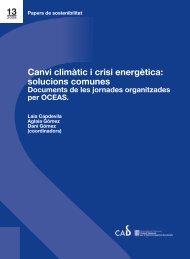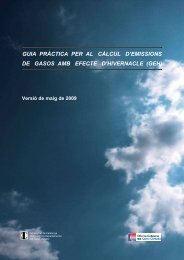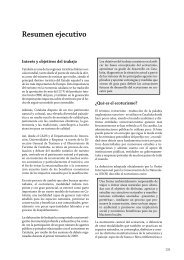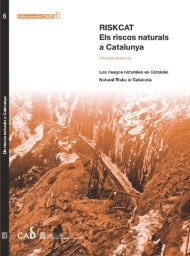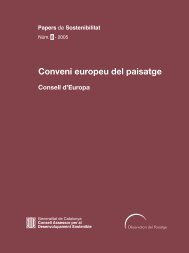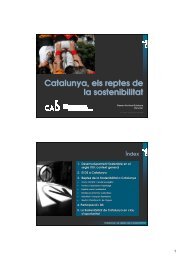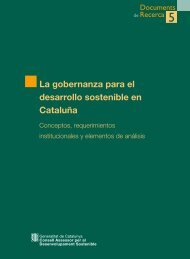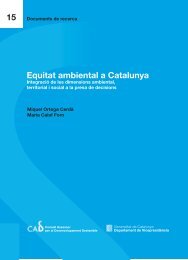Estratègies per al desenvolupament sostenible - Generalitat de ...
Estratègies per al desenvolupament sostenible - Generalitat de ...
Estratègies per al desenvolupament sostenible - Generalitat de ...
You also want an ePaper? Increase the reach of your titles
YUMPU automatically turns print PDFs into web optimized ePapers that Google loves.
La resposta, princip<strong>al</strong>ment en forma <strong>de</strong> <strong>de</strong>cisions polítiques i soci<strong>al</strong>s,mesures i polítiques. Els indicadors <strong>de</strong> resposta s’orienten cap a la conformitatlegislativa o <strong>al</strong>tres esforços governament<strong>al</strong>s, <strong>per</strong>ò no indiquen directamentquè passa amb el medi ambient. Els indicadors <strong>de</strong> resposta han <strong>de</strong> po<strong>de</strong>restablir la política o el programa més rellevant amb relació a qu<strong>al</strong>sevol forçamotriu o indicador d'estat.Aquest marc <strong>de</strong> referència està gener<strong>al</strong>ment acceptat, i molts països elconsi<strong>de</strong>ren útil <strong>per</strong> elaborar els informes sobre l’estat <strong>de</strong>l medi ambient.Diverses organitzacions, basant-se en el treb<strong>al</strong>l inici<strong>al</strong> <strong>de</strong> l’OCDE, han creati estan creant llistes d’afers ambient<strong>al</strong>s –amb els indicadors <strong>de</strong> pressió-estatrespostacorresponents–. Itàlia, <strong>per</strong> exemple, publica cada dos anys un informenacion<strong>al</strong> sobre l’estat <strong>de</strong>l medi ambient utilitzant aquest marc <strong>de</strong> referència iestà establint un sistema nacion<strong>al</strong> <strong>de</strong> monitoratge seguint els mateixos patrons.En els seus informes sobre l’estat <strong>de</strong>l medi ambient, l’Agència Europea <strong>de</strong>lMedi Ambient (seguint una proposta <strong>de</strong> Dinamarca), amplia el plantejamenta un mo<strong>de</strong>l <strong>de</strong> “forces motrius–pressions–estat–impactes–resposta” <strong>per</strong>quètambé promou l’av<strong>al</strong>uació <strong>de</strong> l’a<strong>de</strong>quació <strong>de</strong> les respostes polítiques a lespressions que hi ha sobre els recursos natur<strong>al</strong>s 17 .El marc <strong>de</strong> referència pressió–estat–resposta funciona <strong>per</strong> a aquesta menad’av<strong>al</strong>uacions ambient<strong>al</strong>s (<strong>per</strong> a les qu<strong>al</strong>s va ser dissenyat). No obstant això,no és tan adient <strong>per</strong> a l’av<strong>al</strong>uació <strong>de</strong> la sostenibilitat, ja que tracta les aspiracionsi les activitats humanes simplement com a problemes ambient<strong>al</strong>s. Tot i quela CSD va provar <strong>de</strong> solucionar-ho canviant pressions <strong>per</strong> “forces motrius”,<strong>al</strong>s usuaris els costava encara més discernir estats, forces motrius i respostes(p. ex. les respostes són sovint forces motrius). També era complicat i<strong>de</strong>ntificarun indicador <strong>per</strong> a cada estat, cada força motriu i cada resposta.6217 B<strong>al</strong>dock, D. “Developing and Using Agri-environment<strong>al</strong> Indicators for Policy Purposes: OECD CountryEx<strong>per</strong>iences” a Environment<strong>al</strong> Indicators for Agriculture, vol. 2, Issues and Design. París: OCDE, 1999.




